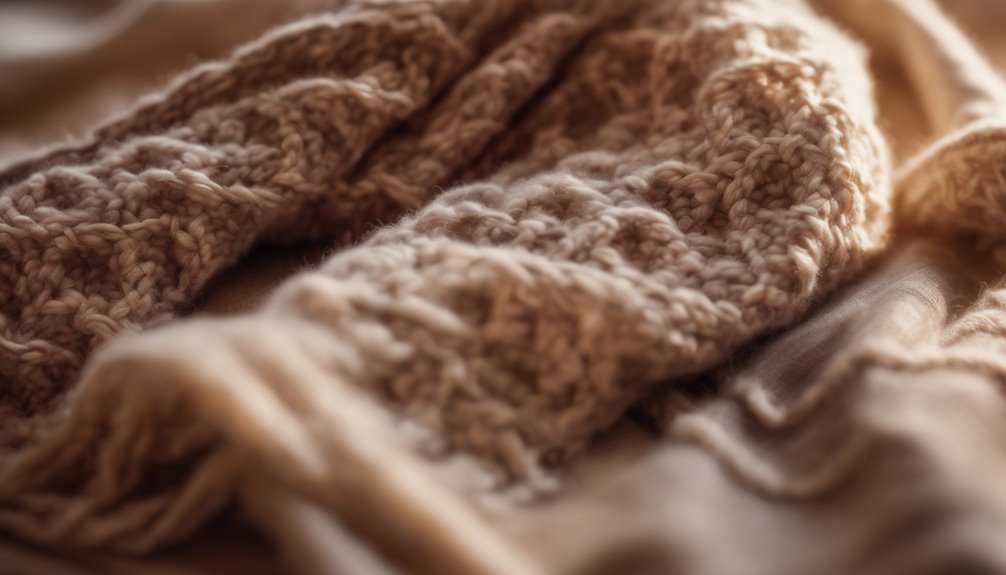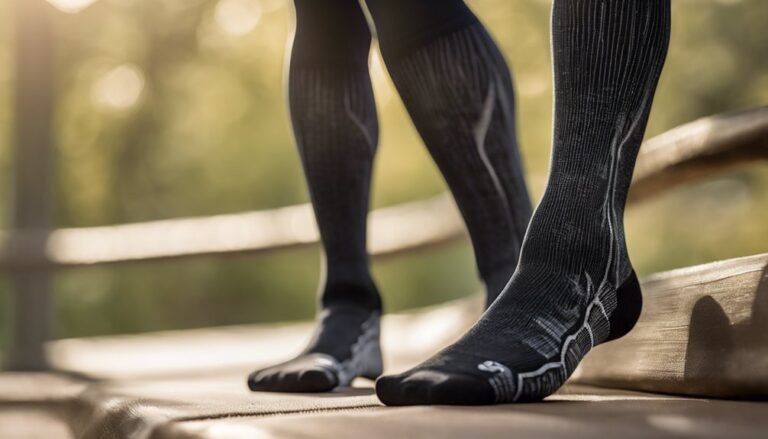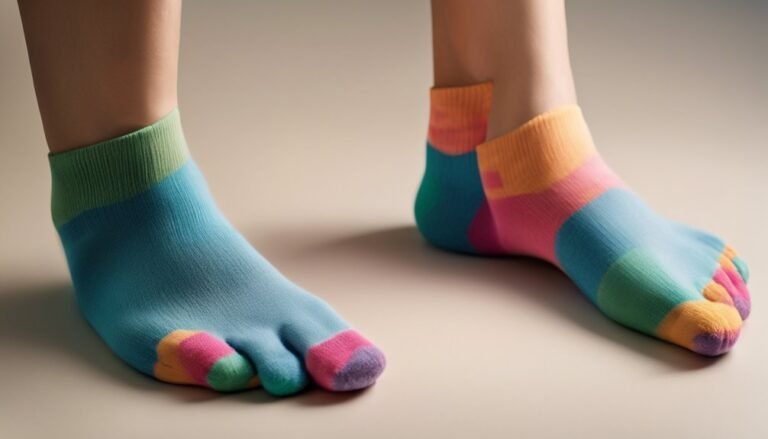How Thermal Socks Work to Keep Feet Warm
Thermal socks work by utilizing insulation materials, like Merino wool and synthetic blends, to trap warmth generated by your feet while minimizing heat loss. Advanced moisture-wicking technology quickly absorbs sweat, keeping your feet dry and reducing the risk of frostbite or blisters. Breathable fabrics allow for temperature regulation and airflow, enhancing comfort during prolonged wear. For ideal warmth and performance, it is crucial to understand the different types of thermal socks available and their specific benefits.
The Importance of Insulation in Thermal Socks

When you think about staying warm in cold conditions, the insulation properties of thermal socks become vital. These socks are designed to enhance heat retention, effectively trapping warmth generated by your feet. The insulation benefits stem from the unique construction that minimizes heat loss while allowing moisture control. By creating a barrier between your skin and cold air, thermal socks greatly reduce the risk of frostbite and discomfort. Their ability to wick moisture also prevents dampness, which can lead to chilling. This combination of heat retention and moisture management not only keeps your feet warm but also promotes overall foot health. Investing in high-quality thermal socks is essential for anyone seeking freedom to enjoy outdoor activities, regardless of the weather.
Materials That Make Thermal Socks Effective
To understand how thermal socks keep your feet warm, you need to take into account the specific materials involved. Insulating fibers, moisture-wicking technologies, and the thickness and cushioning of the socks all play vital roles in maintaining warmth and comfort. Each of these factors contributes to the overall effectiveness of thermal socks in cold conditions.
Insulating Fibers Utilized
Although various materials are employed in the construction of thermal socks, specific insulating fibers play an essential role in their effectiveness. These insulating materials are designed to trap heat and create a barrier against cold. Here are some key fiber technologies that enhance warmth:
- Merino Wool: Excellent natural insulator, managing moisture and regulating temperature.
- Thinsulate: A synthetic fiber known for its lightweight insulation properties.
- Polar Fleece: Offers superior warmth without the bulk, making it ideal for thermal socks.
- Acrylic Blends: Often used for added durability and softness, complementing other insulating materials.
Moisture-Wicking Technologies
Insulating fibers alone can't guarantee warmth if moisture is allowed to accumulate. That's where moisture-wicking technologies come into play. These advanced fabric technologies are designed to actively manage moisture by drawing sweat away from your skin, transferring it to the outer layer of the sock where it can evaporate. This process keeps your feet dry, which is critical for maintaining warmth in cold conditions. Materials like merino wool, polyester, and nylon often incorporate specialized weaves that enhance moisture management without compromising breathability. By utilizing these innovative fabrics, thermal socks assure that you stay comfortable during outdoor activities, allowing you the freedom to enjoy your adventures without the discomfort of damp feet.
Thickness and Cushioning
When selecting thermal socks, thickness and cushioning play essential roles in their effectiveness. The right combination guarantees warmth while maintaining comfort. Consider these factors:
- Sock Density: Higher density typically means better insulation.
- Cushioning Types: Different cushioning types, like targeted or all-over, affect fit and warmth.
- Material Composition: Wool blends offer superior insulation without bulk.
- Fit and Design: Ergonomic designs enhance thermal retention.
Thicker socks generally provide increased warmth, but they must balance with breathability to prevent overheating. Additionally, proper cushioning types can reduce pressure points, improving overall comfort. When you understand these elements, you can choose thermal socks that not only keep your feet warm but also allow for freedom of movement in any environment.
Moisture Wicking: Keeping Feet Dry
Moisture management is essential for maintaining warmth in cold environments, as wet feet can quickly lead to discomfort and hypothermia. Thermal socks employ advanced moisture-wicking technology that actively draws sweat away from your skin, promoting rapid moisture absorption. This process not only keeps your feet dry but also enhances foot health by reducing the risk of blisters and fungal infections. By utilizing synthetic fibers or merino wool, these socks create a capillary action that transports moisture to the outer layer, where it can evaporate. The result is a comfortable, warm foot environment that allows you to enjoy your outdoor activities without the burden of wetness. Prioritizing moisture wicking in your sock choice is vital for peak performance and protection.
The Role of Breathability in Comfort

Breathability plays an essential role in ensuring comfort during cold-weather activities, particularly when it comes to thermal socks. When you're active, your feet generate heat and moisture. This is where breathable fabrics shine, allowing for effective temperature regulation to keep your feet comfortable.
- Moisture Management: Prevents clamminess by allowing moisture to escape.
- Temperature Control: Helps maintain an ideal temperature, avoiding overheating.
- Odor Reduction: Promotes airflow, reducing unpleasant smells.
- Enhanced Comfort: Keeps your feet feeling fresh during extended wear.
Choosing thermal socks with proper breathability means you can enjoy your adventures without the distraction of damp or overheated feet. With the right pair, you'll experience freedom of movement and comfort, no matter how long you're out in the cold.
Different Types of Thermal Socks
Numerous types of thermal socks cater to different activities and environments, each designed with specific materials and construction techniques to maximize warmth and comfort. For instance, cotton blends are popular for everyday wear, offering moisture-wicking properties along with a soft touch, ensuring your feet stay dry and cozy. On the other hand, wool options, such as merino wool, excel in insulation and temperature regulation, making them ideal for strenuous outdoor activities in cold weather. Additionally, you'll find specialized thermal socks with reinforced cushioning for hiking or skiing, featuring arch support and moisture management. Understanding these variations allows you to choose the best thermal sock for your specific needs, ensuring your feet stay warm and comfortable, no matter the environment.
How to Choose the Right Thermal Socks
When selecting the right thermal socks, how can you guarantee they meet your specific needs? Start by considering the following factors:
- Thermal sock types: Choose between lightweight, midweight, or heavyweight based on your activity level and temperature exposure.
- Material composition: Look for blends that include merino wool or synthetic fibers for effective moisture-wicking and insulation.
- Sock fit: Ascertain they fit snugly without being restrictive; poorly fitting socks can lead to blisters and discomfort.
- Thickness: Decide on thickness based on the footwear you'll wear, balancing warmth with mobility.
Care and Maintenance for Longevity

Selecting the right thermal socks is just the beginning; proper care and maintenance are key to ensuring they perform effectively over time. Follow these care tips and washing guidelines to maximize their longevity:
| Care Tips | Washing Guidelines |
|---|---|
| Air dry after use | Machine wash cold |
| Store in a cool place | Avoid bleach |
| Rotate pairs regularly | Use mild detergent |
| Avoid fabric softeners | Hand wash when possible |
| Inspect for wear | Tumble dry low if needed |
Frequently Asked Questions
Can Thermal Socks Be Worn With Any Type of Footwear?
Absolutely, thermal socks can complement various footwear styles. Your fashion choices won't be limited, but comfort levels may vary. Confirm the sock material and thickness align with your preferred shoes for ideal fit and warmth.
How Often Should Thermal Socks Be Replaced?
You should replace thermal socks every 6 to 12 months, depending on usage. Regularly evaluating their condition guarantees peak performance, as sock lifespan diminishes with wear, impacting insulation and comfort during cold activities.
Are Thermal Socks Suitable for Sensitive Skin?
Imagine a gentle embrace for your feet. Thermal socks, crafted from soft materials, offer sensitive skin benefits by reducing irritation. Their breathable fibers guarantee comfort, allowing you to explore the world without worry or discomfort.
Do Thermal Socks Come in Different Thicknesses?
Yes, thermal socks come in various thicknesses. Thicker options often feature advanced thermal sock materials, enhancing thermal insulation properties, while thinner styles may prioritize breathability, ensuring you can choose based on your specific comfort and activity needs.
Can Thermal Socks Be Used for Outdoor Sports?
Like a reliable shield in battle, thermal socks excel in outdoor activities. They provide excellent moisture management, ensuring your feet stay warm and dry, essential for peak performance and comfort during long hours outside in cold conditions.







